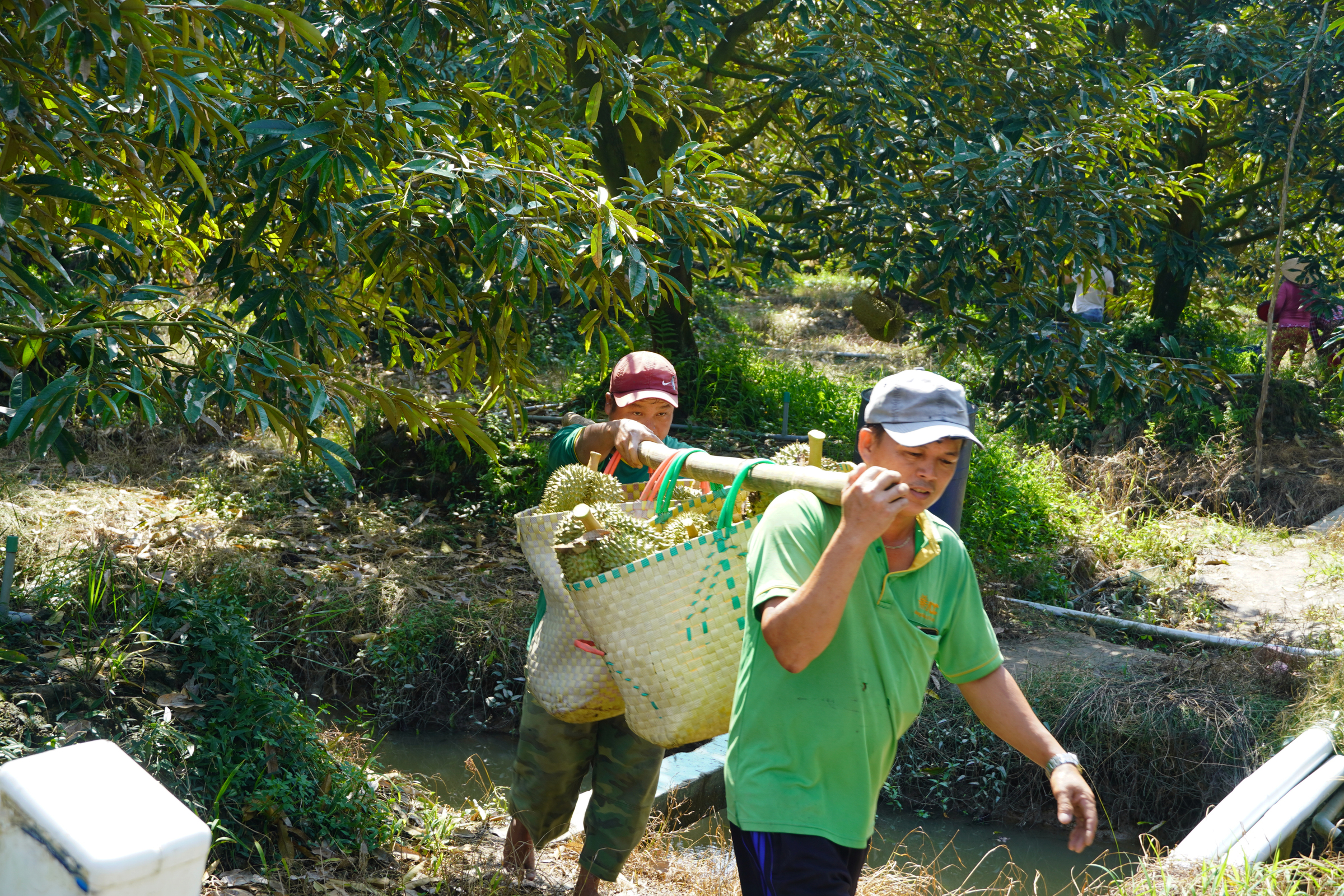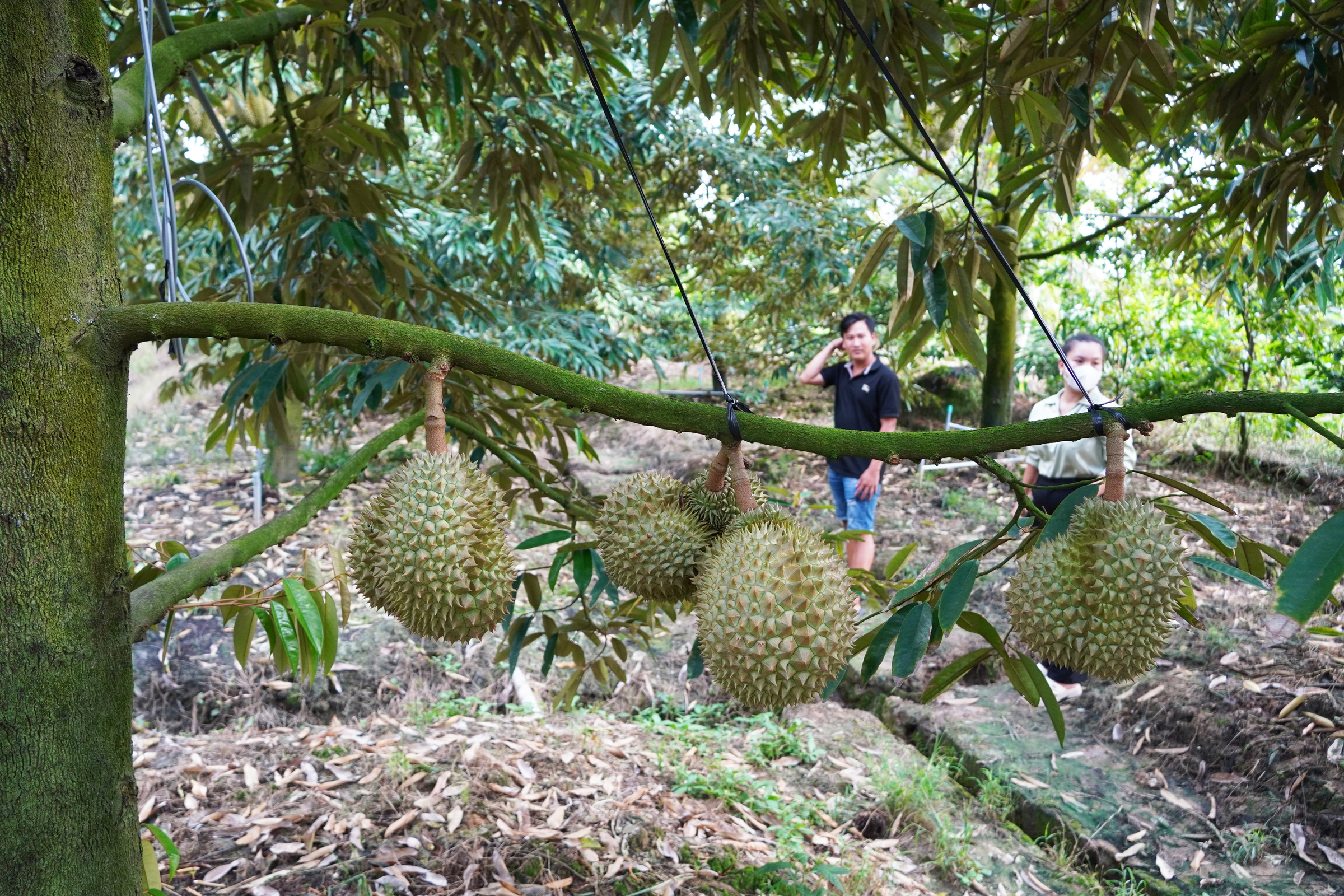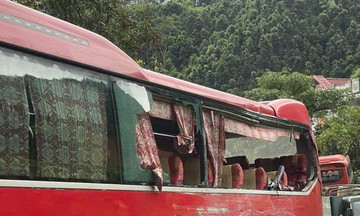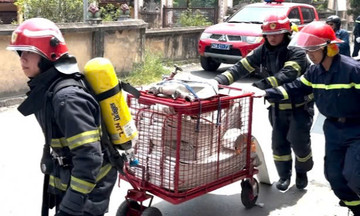Nguyen Thanh Binh, a durian farmer with nearly 20 years of experience in Cai Lay district (Tien Giang), recently sold 9 tons of Ri6 and Mongthon durians for 30,000 VND/kg, earning a profit of 30 million VND on his 3,000 m2 farm. "This price is a record low. The profit is practically just compensation for a year's work," he said.
According to Binh, the biggest challenge is the unavoidable post-harvest care costs. Every week, he spends one million VND on foliar sprays for new shoots. During the flowering stage, spraying for fruit and leaves doubles, not including fertilizer costs. "If I stop investing, the trees will weaken or die, which would be a total loss," he said. On average, production costs fluctuate between 28,000-38,000 VND/kg, depending on material prices.
 |
Durian harvest in Cai Lay town, Tien Giang. Photo: Hoang Nam |
Durian harvest in Cai Lay town, Tien Giang. Photo: Hoang Nam
About 50 km away, Luong Nhu Y, owner of a 5,000 m2 durian farm in My Long commune (Dong Thap), only recouped his investment of over 500 million VND and earned a profit of 60 million VND after three harvests, spanning 7 years. According to him, each subsequent harvest also costs hundreds of millions of VND. "I can't abandon the farm, but further investment brings fear of losses," he said.
According to Dr. Le Quoc Dien, former director of the Center for Science and Technology Transfer at the Southern Fruit Research Institute, durian trees only begin to bear fruit after 5 years. Forcing early fruiting weakens the trees, potentially leading to irreversible death.
The care process requires strict techniques, from pruning and canopy shaping to nutrition and fruiting management. Each tree should be kept under 5 m tall, with a maximum of 18 branches, bearing around 80 fruits. The ratio of old to new leaves should be maintained at 60/40. Incorrect fertilization can cause the fruit to become hard, weaken the tree, and ultimately kill it.
Durian is also difficult to intercrop with short-term crops due to its high nutritional requirements, which can easily waterlog the roots of other plants. This is why durian is often called the "royal tree" or "rich man's tree".
Dr. Dien explained that the initial investment is substantial, ranging from 1-3 billion VND per hectare over 5 years, depending on soil conditions. Once fruiting begins, each hectare requires about 500 million VND annually for fertilizer, pesticides, and labor. If investment ceases, the trees will weaken and die.
"The long cultivation period and high capital investment make many farmers vulnerable to poverty. Some are forced to sell their farms before the trees bear fruit due to depleted funds and inability to borrow further," he said.
 |
Durian prices have plummeted, but farmers cannot stop the high investment costs for fear of the trees weakening and dying. Photo: Hoang Nam |
Durian prices have plummeted, but farmers cannot stop the high investment costs for fear of the trees weakening and dying. Photo: Hoang Nam
From 2015 to 2024, the durian acreage nationwide increased fivefold, from 32,000 ha to over 178,000 ha, with a yield of over 1.5 million tons. Of this, the Mekong Delta accounts for about 35,000 ha, with Tien Giang alone accounting for 24,000 ha.
However, current durian prices are only one-third of what they were this time last year. The main reason is China, the largest export market, tightening inspections for aurum, a compound with potential cancer risks, leading to many shipments being returned and having to be sold domestically at low prices.
In 2023, durian exports reached a record 3.3 billion USD, accounting for nearly half the value of fruit and vegetable exports. But in just the first two months of this year, export turnover decreased by 69% to 52.7 million USD; exports to China alone fell by 83% to 27 million USD. Durian dropped from the number one export position to third, behind dragon fruit and bananas.
According to Le Chi Thien, director of the Dong Thap Department of Agriculture and Environment, the decline in durian prices is a region-wide trend. In the immediate future, local authorities are increasing technical training, guiding farmers to improve fruit quality, limit pesticide residues, and find solutions to reduce costs to enhance resilience during this period of price volatility.
Ngoc Tai












